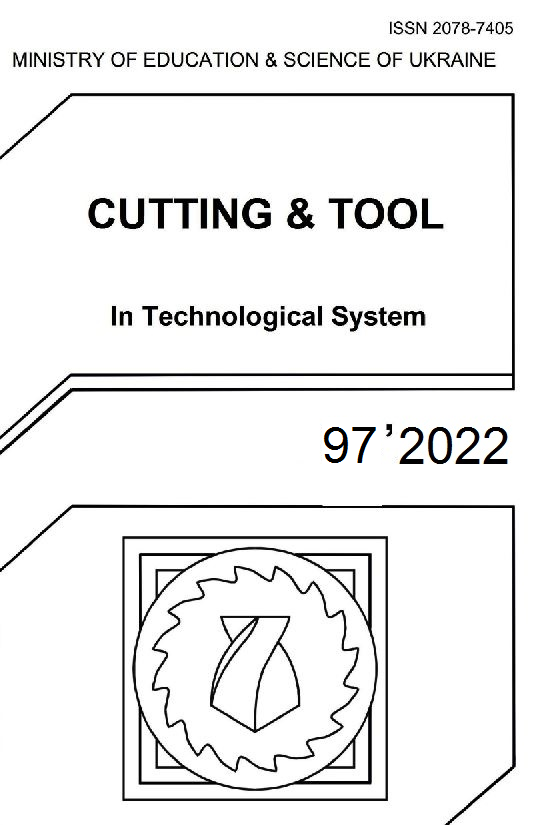CAUSES OF DIFFERENT WAVES OF MACHINED SURFACES AFTER UP AND DOWN END-MILLING
DOI:
https://doi.org/10.20998/2078-7405.2022.97.03Keywords:
milling, self-oscillation, waviness, pitch, height, cutting surfaceAbstract
In modern industry, among the methods of surface treatment is widely used end-milling. Under certain conditions of its use there are self-oscillations, which significantly affect the quality of the treated surface. Various techniques are used to study this influence, in particular, the comparison of the basic fragments of the oscillogram obtained by cutting with the treated surface. It is established that it is formed by the first and last wave of self-oscillations during up and down milling, respectively. But depending on the direction of feed step and the height of the waviness on it have different meanings. Therefore, it is important to determine the reasons that lead to this result. This paper considers the features of each direction of supply that affect the formation of the treated surface. When superimposing fragments of the oscillogram obtained by up milling, it is seen that the deviation of the first wave of self-oscillations from the position of elastic equilibrium starts from the point of incision of the cutter in the part. Therefore, the pitch of the wave on the treated surface depends on the feed and the number of cuts required to cut the first protrusion on the cutting surface. The paper presents a formula for determining the length of the base of this speech. When using it, the discrepancy between the calculated wave step on the treated surface and the measured one does not exceed 4%. In the case of down milling, the last section with waviness on the cutting surface, which is cut and affects the shape of the treated surface, has a shorter base length than the opposite. This is the first reason why the pitch of the wave in the down milling is smaller than in the up. Also at formation of wave on the processed surface at down milling the feature in the form of shift on a phase of waves of self-oscillations on each following cut is observed. This increases the cutting time and the length of the cutting surface. Each subsequent forming depression is shifted towards the treated surface with a decrease in its deviation from the position of elastic equilibrium. However, the phase shift direction is opposite to the feed direction. This is the second reason why the pitch of the wave on the machined surface after the down milling is less than after the up. The calculation of the step of the wave of the treated surface after the down milling according to the results of the study of fragments of oscillograms shows that the error does not exceed 12% compared to the measured one.
References
Sokolovskij A.P. Tochnost' obrabotki na metallorezhushhih stankah. Moscow : Mashgiz, 1952. 289 p.
Korsakov V.S. Tochnost' mehanicheskoj obrabotki. Moscow: Mashgiz; 1961. 378 p.
Kedrov S.S. Kolebanija metallorezhushhih stankov. Moscow: Mashinostroenie; 1978. 200 р.
Matalin A.A. Tehnologija mehanicheskoj obrabotki. Leningrad: Mashinostroenij; 1977. 464 p.
Reshetov D.N., Portman V.T. Tochnost' metallorezhushhih stankov. Moscow: Mashinostroenie; 1986. 336 р.
Kolev K.S. Rosev L.M. Tochnost' obrabotki i rezhimy rezanija. Moscow: Mashinostroenie; 1976. 144 р.
Dyaya S.I, Kozlova Ye.B, Kondratyuk E.V, Zubarev A.E, Krishtal V.A. Systematization of vibrations during end milling of thin-walled elements of parts. Engine Building Bulletin. 2016;1:68-71.
Vnukov Yu.N, Dyaya S.I, Kozlova Ye.B, Logominov V.A, Chernovol N.N. Self-oscillations when milling thin-walled elements of parts. Zaporizhzhia: ZNTU; 2017. 208 p.
Dyaya S.I, Kozlova Ye.B, Germashev A.I, Kuchugurov M.V. Influence of the self-oscillation period on the formation of the profile of the machined surface during end cylindrical milling. Cutting Tools in Technological Systems. 2019;91: pp. 24–36.
Mozgovoy V.F, Dyaya S.I., Kozlova Ye.B, Logominov V.A, Zubarev A.E. Formation of the profile of the machined surface during end cylindrical milling under conditions of self-oscillation. Bulletin of Engine Building. 2018;1: pp. 92–100.
Dyaya S, Kozlova Ye, Germashev A, Leschenko A. Features of Peripheral End milling: Formation of Machined Surface Profile. Advances in Engineering Research. 2019; 188: pp. 184–188.
Downloads
Published
Issue
Section
License
Copyright Notice
Authors who publish with this Collection agree to the following terms:
1. Authors retain copyright and grant the Collection right of first publication with the work simultaneously licensed under a Creative Commons Attribution License that allows others to share the work with an acknowledgement of the work's authorship and initial publication in this Collection.
2. Authors are able to enter into separate, additional contractual arrangements for the non-exclusive distribution of the Collection's published version of the work (e.g., post it to an institutional repository or publish it in a book), with an acknowledgement of its initial publication in this Collection.
3. Authors are permitted and encouraged to post their work online (e.g., in institutional repositories or on their website) prior to and during the submission process, as it can lead to productive exchanges, as well as earlier and greater citation of published work.

